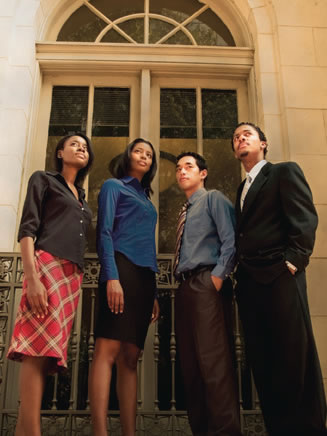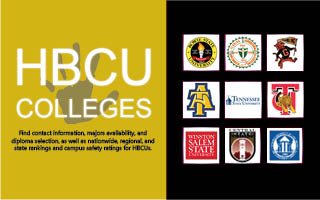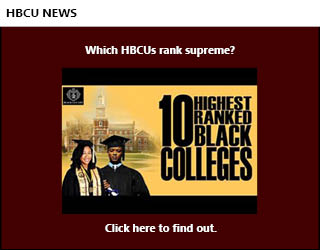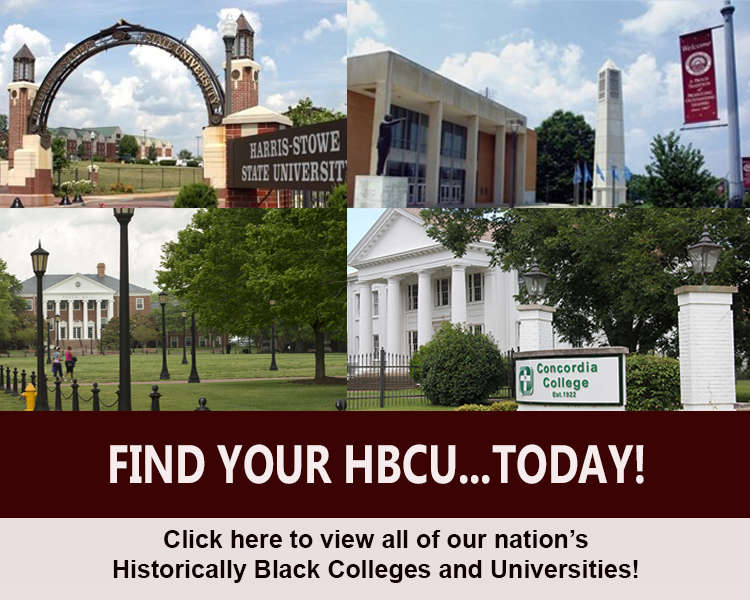HBCUs Past, Present & Future
- Details
Quality HBCU educational experiences are found not just in large, well-endowed private schools like Howard, Hampton or Tuskegee. From North Carolina A&T to Grambling State University, there are strong HBCUs across the country. Many of these state schools were created as "land grant" institutions after the Civil War to educate freed slaves. Today, although their missions have broadened, schools like Florida A&M, Prairie View A&M, Jackson State, Texas Southern University, and Alabama State University still carry the proud HBCU name and traditions.
Prior to the Civil War, it was against the law for slaves to be educated. Although there were exceptions, like self-educated Frederick Douglass, there were almost no formal educational opportunities for people of color. In the early 1830s, a group of Philadelphia Quakers started to educate some blacks at Oberlin College in Ohio and Berea College in Kentucky, but it would take decades of court battles and congressional laws for change to come.
Following the Civil War, Congress passed the 13th Amendment abolishing slavery. In 1862, Senator Justin Morrill led a movement to train Americans in the applied sciences, agriculture, and engineering. The Morrill Land- Grant Act gave federal lands to the states for the purpose of opening colleges and universities. Initially, few opportunities were created for freed slaves, but three decades later, the freedmen finally got their chance when Congress passed the second Morrill Land-Grant Act of 1890.
In the wake of the Morrill Land-Grant Act of 1890, sixteen black institutions opened after they received landgrant funds. The American Missionary Association (AMA) and the Freedmen's Bureau would continue to set up colleges for blacks, and between 1861 and 1870, the AMA founded seven black colleges and thirteen normal (teaching) schools. These institutions would become the bedrock of black higher education. For the next fifty years, HBCUs would flourish. Although funds were low and students often needed financial support from family and friends, they were getting something more than could be placed in a bank.
In 1928, HBCUs gained more support when the Southern Association of Colleges and Schools began to accredit some schools. Even though the Great Depression and World War II crippled many black institutions, most kept their doors opened thanks to churches, a growing black community, philanthropists, and a new organization called the United Negro College Fund.
In 1954, the historic case Supreme Court Brown v. The Board of Education of Topeka, Kansas, ruled that the nation's "separate but equal" system of education was unconstitutional. The case was won by a group of lawyers trained at Howard University that included a young lawyer by the name of Thurgood Marshall. A decade later, Congress passed the Civil Rights Act of 1964 that gave the federal government greater power to enforce desegregation.
In 1965, the federal government provided additional funding to HBCUs through the Higher Education Act. Then came Adams v. Richardson, a Supreme Court decision that found ten states in violation of the Civil Rights Act for supporting segregated schools.
While HBCUs gained in influence and resources because of government mandates and court decisions, in the last two decades, court-issued rulings have threatened the existence of some state-funded HBCUs that have duplicate programs as other state institutions often located in the same areas.
In 1992, the United States Supreme Court ruled in United States v. Fordice that dual and segregated educational systems were unconstitutional; since that time, many HBCUs have become more diverse than ever.
A Culture of Inclusion
Dr. Barbara R. Hatton, former president of South Carolina State University, points out that institutions like Florida A&M, Tuskegee, Alabama A&M, South Carolina Sate, and North Carolina A&T have done well because they were federal land-grant institutions dedicated to educating freed slaves. "In the old segregated days you had white land-grant institutions and black institutions, and that funding still exists today," she said.
Even though African-American students have more educational options than ever, many continue to choose HBCUs. Leah Dixon had a briefcase full of college admission letters, but the twenty-year-old from Hampton, Virginia, traveled a few miles away from home and enrolled at Norfolk State University in an historic city that is home to one of the test cases for the landmark Brown v. Board of Education desegregation case.
Austin Cobb also had plenty of choices for college,

but the nineteen-year-old from Philadelphia headed to Alabama, to Tuskegee University, because he wanted to major in animal science.
And although 19-year-old Paul Henry just wanted to leave New Orleans and go into the Air Force after Hurricane Katrina, a family member convinced him to go to college, so he attended Tuskegee University because he knew he wouldn't be treated like just another student.
Today, the mandate is strong and the mission is undaunted on HBCU campuses across the country. According to each of these students, attending an HBCU has been a life-changing experience that began on the day they arrived on the campus with a big trunk and too many warm sweaters.
Leah Dixon said she went to Norfolk State because, "I got a chance to be around a culture like no other." Cobb is fulfilling his dream of majoring in animal science "because of the warmth of the faculty and staff," and Henry is glad that he didn't go into the Air Force or another school because, "They care about you [here] while at another university you might be just another name."
Rev. Grainger Browning is pastor of the 10,000-member Ebenezer African Methodist Episcopal Church in Fort Washington, Maryland, one of the most affluent predominantly black jurisdictions in the country. Even though his children and many young people in his church could afford to go to any school, Browning is a strong supporter of HBCUs. His father was a professor at Hampton University in the 1960s, and today his son attends Morehouse, and his daughter is a student at Hampton University.
"It was always clear that I was going to Hampton to be free of not having to deal with racism," said Browning. "It changed my life. I had never been in a position of leadership. You have to be able to go as far as you can with nothing being able to stop you but you."
Impact on History
While alumni and students talk about their affinities for HBCUs, these institutions offer more than warm and fuzzy anecdotes of success. The glaring reality is that without the role and function of HBCUs, the landscape of America would be quite different. Had it not been for the desire of Heman Marion Sweat and a rejection letter from the University of Texas Law School, there would not have been a Texas Southern Law School. Had there not been a Dr. Benjamin Mays at Morehouse, there might not have been a Martin Luther King, Jr. Had there not been a George Washington Carver at Tuskegee, there might not have been a Skippy peanut butter or a Ponds cold cream.
The nation's 104 HBCUs are having an impact beyond just educating young people. According to a 2006 report released by the National Center for Educational Statistics, the combined spending of all 101 HBCUs was $6.6 billion in 2001, and of this amount, 62 percent was spent by public HBCUs. Collectively, HBCUs would rank 232 on Forbes Fortune 500 companies. The report goes on to say these schools are not just producing graduates— they have a tremendous economic impact on the communities in which they are located.

According to the report, the 104 HBCUs pumped $4 billion in the labor economy, creating 180,142 full- and parttime jobs. The impact of these institutions was particularly significant in smaller communities. For example, in Tuskegee, Alabama, Tuskegee University hires more than 2,100 workers and accounts for 24 percent of the town's entire labor force. The job picture is similar in Grambling, Louisiana, where Grambling State University employs about 10 percent of the town's workforce.
The 10 largest public HBCUs that are having an economic impact in their community include Florida A&M ($432 million), North Carolina A&T ($298 million), Tennessee State University ($289 million), Southern University ($267 million), Texas Southern ($254 million), Morgan State University ($252 million), Jackson State University ($249 million), Prairie View A&M ($231 million), Norfolk State University ($194 million), and North Carolina Central ($178 million). The largest private schools economically are Howard University ($1.2 billion), Hampton University ($227 million), Clark Atlanta University ($227 million), Meharry Medical College ($173 million), and Xavier University of Louisiana ($154 million). The report also states that the Morehouse School of Medicine and Morehouse College accounted for $212 million combined.
Overcoming Challenges
While HBCUs provide a tremendous opportunity, they also have a big challenge of gleaning critical resources to keep their doors open. "There is a tremendous pressure on small private colleges because of the cost of education today," Judson said. "Their financial support has eroded because of the way they used to get their money from the churches; today there is also a tremendous competition for students."
But despite this challenge, Judson says larger private institutions show that it can be done. He pointed out that institutions like Howard, Hampton, Morehouse, and Spelman have been successful not just because they have great academic reputations, but the leaders of these schools have worked for decades to build large endowments, with the money for these schools generated from the interest of these funds. He says the key for all HBCUs is to adapt to present times because the mission has changed.
Although Grambling is a public school, Judson says it still is important that funds be raised to finance school programs. He has established an endowment and would like to raise $30 million to fund the university's programs. "We are an institution now that is relevant for the twenty-first century," Judson says. "We are inclusive, and we are more effective in the way that we function, providing strong and effective leaders who are also culturally competent."
Hamil R. Harris is an award-winning writer and reporter for The Washington Post.





